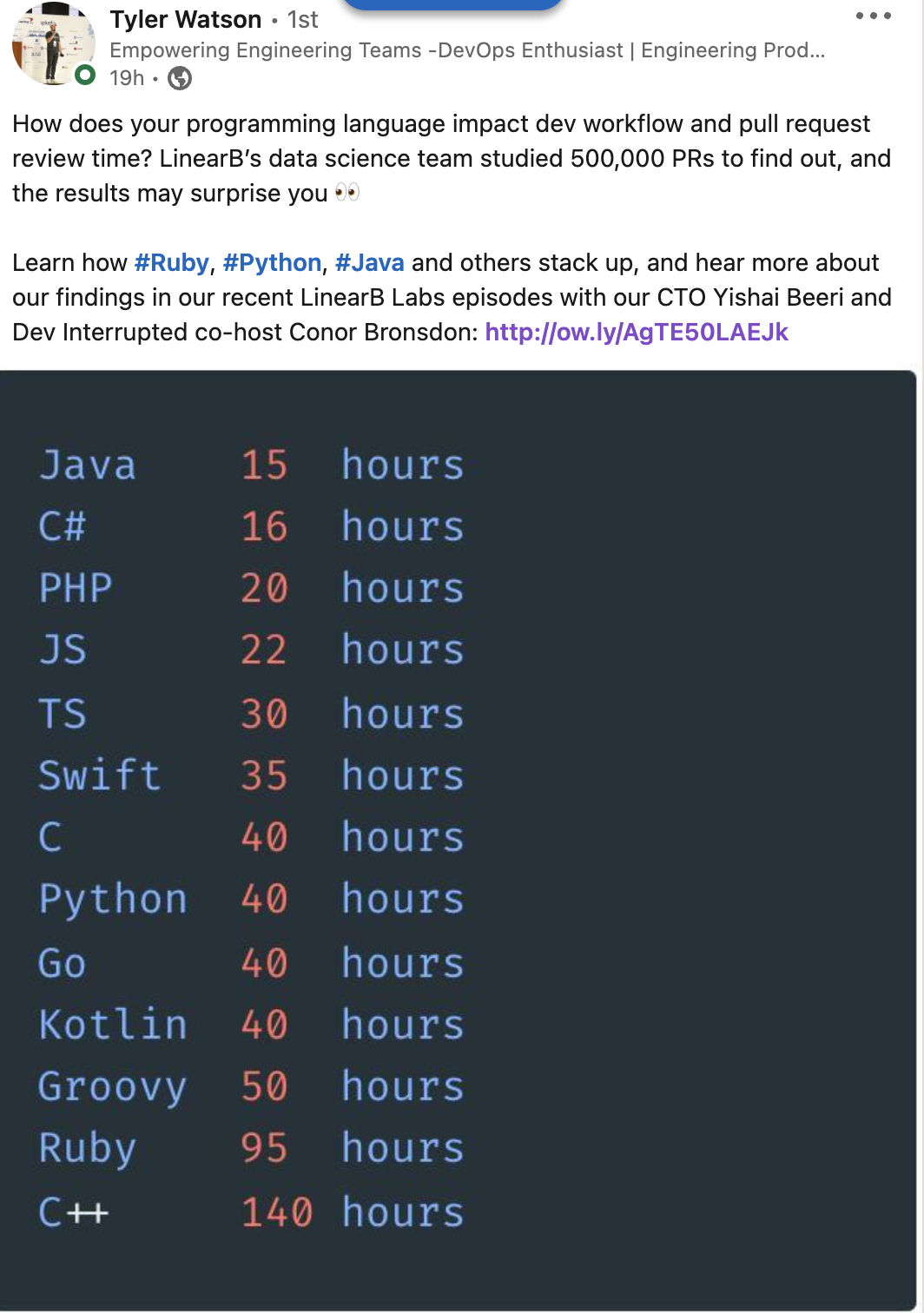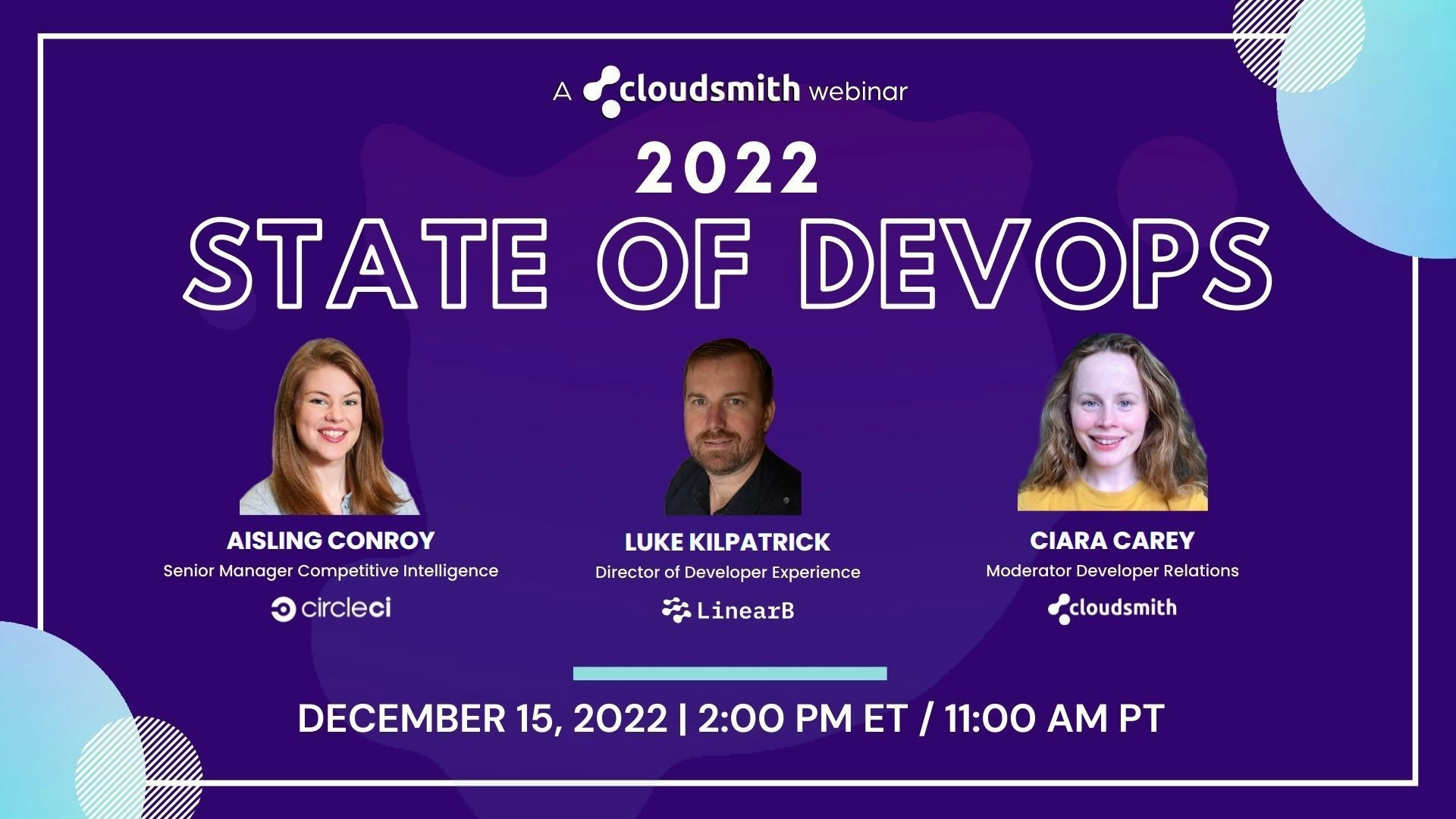What were the trends for DevOps tools and culture in 2022? I talked to Aisling Conroy, Senior Manager of Competitive Intelligence at CircleCI and Luke Kilpatrick Director of Developer Experience at LinearB, to review the year and discuss key learnings and trends at our December webinar.
In 2022 did we get any better at developing software?
- Did we make any headway at automating human frailty out of building software?
- Did AI make a difference in building software?
- Does the focus on multi-cloud mean the death of on-prem?
- How healthy is open source after the big shock of Log4Shell?
2022 started with a huge amount of ambition from tech companies which did so well during the pandemic. As the year went on, the belt tightened, and so did plans; as Aisling put it, "everyone has a plan until you get punched in the face." She notes although the grand plans may not have been executed, we got a lot done, but there is still much more to do.
Some of the 2022 trends Luke and Aisling identified included:
- Shorter pipelines
- Identifying flaky tests
- Platform Engineering dedicated to improving workflow
- AI tools to augment the software developer
- Improved health of open source
I'm going to sum up 2022 DevOps as "the year of the workflow", where we have dedicated people and tools focused on fixing and improving workflows.
Speeding up the DevOps Workflow
Both Linear B and CircleCI are trying to speed up developer workflow.
Aisling tells us that at CircleCI, they want an optimal-size pipeline run of around 10 mins. She sees pipelines on the CircleCI platform become more advanced as customers build more advanced applications than ever, but in some cases, software delivery cycle times have stagnated. "Teams have gone from once a quarter to once a month, which is great, but ideally, we want teams to be able to move at the speed of their creativity."
To improve speed, Aisling tells us there is a focus on tooling, better integrations, interoperability, and spending less time on the manual stuff to become more efficient.
Luke notes that LinearB's customers tend to do a great job of optimizing the ops pipeline but if there is a problem, there are still humans involved. At LinearB, they have done a lot of research on the developer team workflow. They have looked at 10's of thousands of code reviews (PR's) and other areas where there were bottlenecks and found a massive bottleneck around code reviews. So they took this information and tried to help fix the problem. This is what lead to gitStream. Like most things in computing, humans are usually the slowest part of the system. If you have an amazing CI/CD system using CircleCI or other tools, your deployment and delivery problems get reduced. There has been a ton of amazing work done here in the past 10 years. However, checking quality and making sure good code is getting merged is still hard to do. The gold standard is still a peer review of the code.
The biggest slowdown is a lot of small changes don't need this review and a lot of the big ones need to get reviewed more. So LinearB made a tool to help, and best of all, it's free!
Dedicated Experts in Workflows- Platform Engineering
Luke notes that the previous years in DevOps have been focused on the ops side, and a lot still is, but we saw a lot of great stuff coming out to help the developer side of the house. There is also a shift to Developer Experience improvement, also called platform engineering. This really became a big thing in 2022.
Luke likened a platform engineer to a sous chef working alongside a high-end chef. Most high-end chefs are only as good as their sous chef.
Having dedicated experts at a senior level reviewing and improving pipelines and workflow is a big trend for 2022.
Focus on Flaky Tests
The panel agreed there was a big focus on identifying and improving flaky tests. CI tools are highlighting and running metrics on your testing suite. Rerunning flaky tests or turning them off is not good enough. Companies are expected to do more with less, and robust test suites are an avenue for this.
AI and Software Development
AI tooling for software development is having a moment- from GitHub's CoPilot, CircleCI acquisition of Ponicode to the recent surprise of ChatGPT, which forced StackOverflow to ban answers from the AI tool.
At the start of the year, Aisling was quite bullish on AI, and she saw it being used to help developers.
She notes that this is an example where we all got very excited at the start of 2022, and we all thought we'd be living in a different world by the end of the year. We've seen many companies make efforts in the AI area over the past year, and it's been good progress, but actual progress has not come close to where we anticipated it to be.
But as we see AI tooling moving to where we write code, like CoPilot and Ponicode, it is bound to change how we develop software in the coming years.
Boring Programming Languages are making waves
I love comparing languages- the loyalty people feel towards their chosen programming language and the ecosystems it creates are the closest software comes to football.
Linear B came out with a great study on the best and worst programming Languages for developer workflow. LinearB's metric dashboard has used its data on thousands of dev teams and hundreds of thousands of pull requests to see how languages compare with respect to PR lifespans.
It turns out, that Java and C# have a significantly shorter PR lifespan compared to other languages.

Luke tells us that Java and C# are more mature languages that have great tooling integrated into their workflows.
MultiCloud
This year the discussion around hybrid cloud has shifted to multicloud. I wondered if this meant that on-prem is just yesterday's news - case closed?
Both Luke and Aisling disagreed!
Aisling says that there is always going to be some users that will need on-prem, maybe in niche industries like mining, aerospace etc. The trend has been steady in 2022 and will continue in 2023. MultiCloud will continue to gain more traction. In fact, Google had this as a prediction in their GoogleNext conference in September. There is talk of US legislation specifying that large corporations must follow a multi-cloud strategy. But there are still certain types of computing that customers might want to have in-house. Apple M1 is an example of this, though I think we'll see a lot of progress in the coming year in cloud companies being able to provide a growing variety of configurable compute options.
Luke, as a former Nutanix guy, believes on-prem will always have its place, but cloud tech will be part of it and moving loads from on-prem to public will become easier and faster. The tools for doing this are getting better. At the moment for large organizations, on-prem tends to be cheaper in the long run. Luke sees companies using a burst model where you can use infrastructure out to the cloud for big bursts of traffic.
MultiCloud strategy is definitely a 2022 trend, but it hasn't killed off on-prem just yet.
Open Source as a Whole is Healthier
2022 started with teams scrambling to find out if they were affected by the Log4Shell vulnerability found in a commonly used open source package called Log4J. It has become clear to most teams this year how dependent they are on open source software and that to truly secure software supply chains, a coordinated effort is needed from the whole software community.
For me, 2022 was the year where tooling began to help teams see what open source software is being used in their products and to help secure software supply chains. Open source tools like Sigstore, Grype, Trivy and Syft have made big waves this year.
Security by obscurity is thought less of:
- GitStream is currently being giving it away from free
- If you Open Source something, you better reach a certain standard
Aisling saw a trend in open source to improve interoperability in open source tools with Open Policy Agent tools. She was also impressed with how many open source software delivery tools matured, including Argon and Flux. Both Luke and Aisling see open source in a much healthier place at the end of 2022.
Conclusion
Concentration on workflows from a tooling and human level, appreciation of open source and glimmers of what AI can do to improve software development.
Join us on January 31st for our next webinar, which will continue the State of DevOps discussion - A Look Ahead at 2023. Registration information is coming soon.


